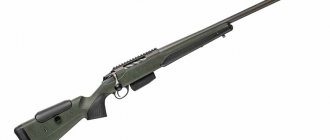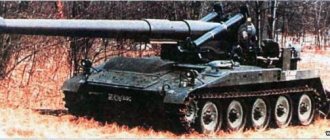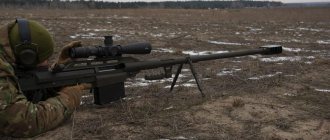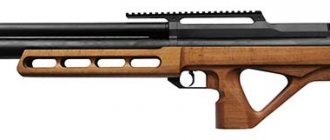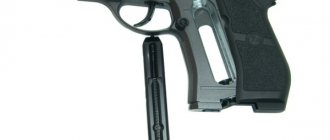Scout rifle: one for all occasions
PHOTO RENTON/FLICKR.COM (CC BY-NC 2.0)
It is believed that the concept of the Scout rifle was put forward by the famous American shooter Jeff Cooper in the early 80s of the last century.
He proposed the idea of a universal rifle, as they say, for all occasions.
According to his ideas, a rifle should be suitable for both hunting and self-defense, while it can be light, compact, convenient and, as follows from the above, the first, and possibly the only, rifle in a hunter’s life.
In our country, such thoughts have never been voiced, although we have long had weapons that quite aspire to the place occupied by Scout rifles in the USA and Europe.
For example, we have a well-developed niche for semi-automatic weapons, and it is on this that designers can easily build a domestic Scout rifle.
So let's look at what we have. Cooper expressed the basic requirements for the new weapon in several postulates.
WEIGHT
The weight of the rifle should not exceed 3.5 kg, while its length is limited to one meter. According to Cooper, such a rifle is compact enough for self-defense and suitable for hunting. According to this criterion, our Mosin carbine and SKS are suitable for the role of a rifle.
| Long focal length sights are also available on carbines with a Henry brace. PHOTO BROWN ALERT/FLICKR.COM (CC BY 2.0) |
Both are compact and convenient, and if we use a plastic stock instead of wood, we will almost meet the weight restrictions.
CALIBER
The caliber of the Scout rifle was strictly limited by Cooper: only .308, no other options were offered. This is understandable, the .308 is the most versatile caliber, suitable for hunting almost any game found in the United States, if, of course, the shooter knows how to shoot locally.
We must not forget that this caliber is in service with the US Army, which makes it possible to buy inexpensive cartridges for target practice.
It is interesting that all these arguments apply to the .30-06 Springfield caliber, so it would be logical to include it in the calibers for Scout rifles, but, apparently, due to the size of the case, which is slightly longer, Cooper did not recognize it quite suitable.
The fact is that an increase in the cartridge will inevitably lead to an increase in the bolt group of the rifle, and consequently, the weight of the weapon will also increase.
In relation to our conditions, the most suitable cartridge for the Scout rifle would be 7.62x54R, which is very close in characteristics to .308, but is more common in our country and is in service with the army.
| Steyer specially created a model of the Scout rifle. PHOTO JINKZ/FLICKR.COM (CC BY-SA 2.0) |
As an alternative, consider our most popular and inexpensive cartridge, the 7.62x39. Although many, including our legislators, consider it not powerful enough, if it can shoot, it is quite suitable for catching food, and, most importantly, it is affordable.
On its basis, it is possible to develop a lightweight and turning carbine in the “Scout” concept.
BOLT OR SEMI-AUTOMATIC?
The operating principle of the Scout carbine was based on the use of a longitudinally sliding bolt with manual reloading. This is a very interesting point, because Cooper himself was calm about semi-automatic rifles, but insisted that a survival carbine should be simple, reliable and trouble-free.
We can agree with him, since in the USA there are not many semi-automatics in .308 caliber that can boast of high reliability and at the same time fall into the category of at least up to four kilograms.
Therefore, the Americans have no choice; only a “bolt” with manual reloading can be light and reliable. In addition, Cooper planned the weapon as inexpensive and accessible, but, as practice has shown, this hope was not justified.
| The Mosin rifle can also be equipped with a long-focus sight. PHOTO WIKIMEDIA.ORG (CC BY 3.0) |
Our situation is somewhat different. After the Mosin rifle, all the efforts of designers and industry were thrown into creating reliable and simple semi-automatic and automatic weapons, which is why in our version the Scout rifle is seen as a semi-automatic weapon.
Ideally, it would be an SKS chambered for the .308 cartridge, but, as I noted above, 7.62x39 is not bad either.
ACCURACY REQUIREMENTS
Cooper established a completely acceptable accuracy of fire - 2MOA (if converted into our usual values, this is approximately 60 mm per 100 m).
This accuracy is sufficient for hunting at a distance of up to 200 meters or for hitting a chest figure at 300–350 m, both with optics and with open sights.
According to this parameter, almost any of our weapons meets Cooper’s requirements (provided that they are not indecently confused), although our army standards for them are somewhat worse.
OPTICS
The last point (but not the last for the rifle itself) we will look at the optical sight, which was proposed (and this is the most unusual thing in this rifle) to be installed at a great distance from the eye.
Of course, if you install a regular sight like this, it will be impossible to use it: for Scout rifles, sights with a long focal length are used, usually these are installed on pistols.
| Ruger offered his own version of the Scout rifle - the Gunsite Scout Rifle. PHOTO RENTON/FLICKR.COM (CC BY-NC 2.0) |
The concept of such sights was developed in Germany during World War II. A weapon with such a sight can be quickly aimed at a target, the sight practically does not block the field of view, and several targets can be quickly hit.
You can quickly work on targets located at different distances from the shooter. This arrangement facilitates quick and correct insertion and eliminates injury from the scope, which can happen even to experienced shooters.
In addition, if the rifle allows you to equip a magazine from a clip, then this function is preserved when installing a scope with a long focus.
There is one more feature: for some weapon models in which the cartridge case is extracted upward (for example, our SKS), the classic arrangement of the optics causes problems.
The cartridges hit the sight and sometimes fly back, interfering with the operation of the reloading mechanism. But with the Scout this does not happen precisely because the sight is moved forward.
Typically, 1-4x scopes are installed on Scout rifles, which is most convenient. With a 1, the sight works like a collimator; with a 4, you can see the target and it is more convenient to shoot locally in calm conditions, when there is enough time to shoot.
In addition, the rifle was conceptually designed to shoot at a maximum of 200 meters, and for such distances a 4x magnification is more than enough.
Sometimes higher magnifications, for example, 2–7x, are installed on a Scout rifle, but high magnifications are not very convenient on sights that are located far from the eyes.
The fact that the sight can be quickly removed, and, if possible, installed while maintaining zeroing, is an important function of the rifle, while the presence of open sights is mandatory, which is unusual for American hunting rifles.
Everything is clear here: after all, a survival weapon must remain working, even if the sight is damaged.
| The forward sight makes loading and unloading the rifle easier. PHOTO RENTON/FLICKR.COM (CC BY-NC 2.0) |
For the domestic weapons school this is not a problem at all. In the concept of our weapon, open sights should be available for use even with an optical sight installed, although in recent years this approach has been abandoned in favor of keeping the optics as low as possible.
Is it good or bad? As always, there are pros and cons to any decision. But if you're going to be shooting out to 200 meters, the fit of the optic isn't that important.
Several years ago there was an attempt to bring to Russia a series of inexpensive “Sturman” optical sights with a long focus.
The purpose of this was to give shooters the opportunity to use such optics in practice. Unfortunately, this attempt did not receive much response, primarily because at that time there were no appropriate brackets and experience in installing them.
| Many consider the Scout to be an excellent hunting rifle. PHOTO TERRY GLAMPER |
In addition, according to the author’s plan, a belt for hand-held shooting should have been attached to the Scout rifle, but it should also be possible to install a bipod and, as an option, a spare magazine placed on the weapon.
WHAT IS THE RESULT?
What has practice shown? Practice has recognized that the concept of a rifle has a right to exist, that such a universal rifle is convenient for the stated purposes.
But not a single manufacturer has been able to provide shooters with an inexpensive rifle that meets all the requirements. Steyer made an excellent Scout rifle: a plastic stock, a sight mounted far in front, a spare magazine in the butt and even a bipod integrated into the forend, and finally, a modern design - everything is great. Everything except the price.
In its basic configuration, the rifle costs $1,500–1,800 (for comparison, a regular Remington 700 costs about $400).
But Cooper’s idea initially envisioned an inexpensive rifle. Rueger, Savage and even Mossberg offered their own versions of the Scout, but they were unable to make a weapon under $700.
Perhaps the name of the inventor, Jeff Cooper, played a cruel joke in pricing: “Scout” has become a brand, and a branded rifle cannot be cheap.
So what's the bottom line? In the USA there are many adherents of the Scout rifle, but it did not become widespread, and most importantly, it did not become the first rifle for the shooter, as planned, a rifle that introduces the world of weapons, shooting and hunting.
Many shooters build their own Scout by taking a regular, off-the-shelf, inexpensive rifle, often used, and fitting it to the parameters put forward by Cooper.
What do we have? Today, any rifle from the USA is very expensive. As I wrote, the most suitable and versatile caliber for us is 7.62x54R, but the choice is not that great. This is a Mosin carbine, close to one meter in length, or a short version of the Tiger carbine.
I think that given our high culture of semi-automatic production (I say this without any irony), we should not abandon them.
"Tiger" is heavy, but this is not its only disadvantage; installing a sight with a long focus will take a lot of brainpower, but if the shooter can handle it, he will get an excellent carbine for all occasions with enormous firepower.
It's easier with a Mosin carbine. If we knock out two transverse pins from the rear sight and move it forward, we are surprised to find that it is attached to a completely standard dovetail bar, which will accept any rings of this format.
All that remains is to find a long-focus scope and, if desired, change the stock to a lighter and more elegant plastic one. The resulting carbine meets almost all the requirements of the Scout rifle concept. I think that in our conditions this is the most interesting option.
I think the concept of the Scout rifle is very interesting and original. It is ideal for the role of a first rifle or a non-specialized weapon, which is stored just in case and for all occasions.
For those who love guns and can afford to have several units, the Cooper rifle can be one of many.
In addition, our laws do not allow you to buy a rifled carbine without experience in owning a smoothbore gun, and defending yourself with one is not very correct from the point of view of the same law.
For self-defense, it is better to buy a shotgun, it will be the first hunting rifle, but for survival it is much better to take the civilian version of the AK. So rifles built according to Jeff Cooper’s concept are unlikely to become widespread on our soil.
Alexander Kudryashov November 19, 2022 at 12:08
Our Scout: AK or SKS?
In the classical sense, the Blazer .308 caliber fits into the concept of a “scout”: lightweight, reliable, accurate, but its price on the American market cannot be called affordable.
Likewise, in our price range, only conversion samples are suitable for a “scout”, and even then not all of them.
There is a good option in 7.62x54 caliber - the Mosin rifle, or more precisely, a carbine: a long barrel is inconvenient for a universal rifle and makes it heavier, but a carbine fits perfectly.
The advantages of the “mosinki” are obvious: inexpensive, easy to use and maintain, absolutely reliable and quite accurate. When choosing, you just need to carefully approach the issue of assessing the wear of the weapon.
If the barrel is new, from Vyatskie Polyany, then this is almost an ideal option: you get a high-quality forged barrel, and even chrome-plated.
If the barrel is “original”, then you will receive a pin in the barrel as a trim mark or core. The latter is preferable, but is extremely rare; small quantities of these rifles, converted at Izhmash, can only be found on the secondary market.
Rifles with a “native” barrel require attention when choosing. Essentially, they should be selected as an aftermarket weapon, carefully assessing barrel wear and remembering that no external inspection can replace a test shoot. As they say, practice is the best indicator of quality.
Read the material “Universal Scout rifle: cartridges and optics”
Installing scout-type optics on a Mosinka is simple: just remove the rear sight and install a sight in its place.
It’s also a good idea to dress the rifle in plastic (although an inexpensive option from ATI was previously available, but today its price does not at all correspond to the concept of a “scout” rifle). As a result, we get an inexpensive, reliable and fairly accurate carbine.
| Purely hunting versions of cartridges are also produced. PHOTO BY ALEXANDER KUDRYASHOV |
The second thing worth considering is a weapon created on the basis of the 7.62x39 cartridge. In my opinion, it is perfectly suited to the role of a universal rifle.
It is compact, lightweight, has low recoil, and, which is important for a universal weapon, its cartridges are relatively inexpensive. Today the 7.62x39 cartridge is one of the most affordable in price.
Due to the huge circulation and prevalence, as well as the fact that it is still in limited service, its price starts at 8 rubles apiece.
At the same time, the cartridge has good ballistics and a good (compared to 5.45x39) stopping effect. So this is the first candidate for our scout rifle ammunition.
It should be noted that bolt-action rifles are also produced for this cartridge, for example the Titan-6 or the old Bars, but they are not easy to find.
Unfortunately, the prices for this and similar weapons cannot be called affordable, although the very idea of having a bolt-action rifle chambered for 7.62x39 looks attractive.
In general, given the price and availability, we can only choose AK-Moids and SKS. Let's talk about them.
AK-SHAPED
This is a huge and diverse world of our weapons. It includes conversions from army AKs, AKMs, RPKs and other modifications of our machine guns and light machine guns produced during the Soviet era.
I must say, the quality of this weapon is very good. If it has not been used and the crimp marks are installed carefully, then such a weapon fully corresponds to the price that is asked for it.
The main problem is how to choose a weapon that has not been used or has been used very little.
Read the material “The FSB shooting at Lubyanka highlighted the problems of Saiga carbines”
The second part of the market is weapons currently produced: the Vepri from the Vyatsko-Polyansky plant and various modifications of the Saiga, produced first by Izhmash and now by the Kalashnikov Concern.
All Vepr carbines are heavy because they are made on a heavier Kalashnikov machine gun frame and are equipped with cold-forged chrome-plated barrels of excellent quality, thicker than on the Saiga.
This makes the products of Vyatskiye Polyany brutal, but immediately affects the weight: all “Vepri”, even with short barrels and in plastic, weigh more than four kilograms.
| The new plastic stock allows you to install a sight or collimator on the gas outlet tube. PHOTO FAB-DEFENSE |
Today, Saigas are made on the basis of the Kalashnikov assault rifle, or rather, on the basis of the hundredth series of these assault rifles. Although they also have a forged and chrome-plated barrel, they weigh just over three and a half kilograms.
All AK-shaped variants are well suited for the role of a domestic “scout” rifle; the weight, of course, is a little high, but we will assume that this is a feature of our weapons and, of course, the price to pay for the fact that we get a semi-automatic rifle, and not a rifle with a manual reloading.
I think this is both possible and correct, I suspect that if Cooper had such a “history” in the form of a large number of high-quality, reliable and, importantly, inexpensive weapons, he would certainly have thought about the version of the semi-automatic Scout rifle.
But let's return to our AKs. Today, installing a long sight on an AK is not a problem.
There are a huge number of options: gas exhaust tubes with an integrated weaver, and covers for these tubes, and a very good bracket that is installed in place of the sighting bar and makes it possible to get a weaver bar in the most convenient place for installing a “scout” sight.
At the same time, when you remove the sight, you get a rear sight (though only at one distance) with which you can shoot. Shoot him straight and you'll always have a backup option in case your optical sight fails.
So, as we see, AK-shaped rifles are quite a successful platform for developing the idea of a completely universal rifle for all occasions. They are simple, reliable, and have a big advantage in the form of a replaceable magazine and, as a result, the ability to use any magazine from five-round to “monster” magazines with seventy-two rounds.
| Option for installing long-focus optics on SCS. PHOTO ROBERT BURNS/FLICKR.COM (CC BY 2.0) |
When installing a “scout” sight, we get a carbine that is convenient to work with almost any animal and at a distance of up to 300 meters.
CARBINES BASED ON SKS
The SKS is good, but in Russia the truly best option to replace the Scout rifle is the SKS, developed at the end of the Great Patriotic War as a carbine, and not as an assault rifle.
With all his appearance he says: “I am a rifle, not a machine gun.” If you like the look of an assault rifle, you can buy a plastic body kit and turn your carbine into a weapon with a folding stock, pistol grip and a high-capacity magazine.
But SKS is truly good in its native form. Of course, you can change the stock to a classic, but plastic one, which will reduce the weight of the carbine and improve the ergonomics, but this is not necessary. The capacity of a standard magazine is ten rounds - what is needed for citizens, since the law prohibits more.
SCS has one advantage that is often underestimated. This is a skewed barrel locking and a longer barrel. An AK with such a barrel becomes bulky, and the SKS is compact (by the way, its length is exactly a meter, like the Mosin carbine).
These design features produce a bullet velocity 10% higher than the same cartridges produce on a standard AK. It would seem that 10% is not much, but for the 7.62x39 cartridge, which teeters on the edge of “weak for hunting,” this is a noticeable figure.
The SKS itself is reliable and unpretentious, has good accuracy and fires almost any 7.62x39 caliber cartridges. I don’t know of a single case when a standard SCS, without alterations and improvements, jammed or caused delays. It works great in both cold and hot weather.
| The 7.62x39 cartridge is one of the most common in the world. |
SKS has always had the problem of installing an optical sight. On the one hand, it does not have a standard mount for a sight, and therefore there are no universal brackets, like the Saiga.
On the other hand, the SKS ejects the cartridges upward, so if the sight is mounted traditionally, then you need to figure out how to change the direction of ejection of the cartridges so that they do not hit the sight.
In this case, a long-focus sight is an excellent choice: it does not block the bolt, it remains possible to load the weapon from clips, and in addition, it does not interfere with the cartridges flying out after the shot.
Such a sight expands the capabilities of the SKS, especially if it is variable, say, from 1 to 3. With such a sight, at short distances the sight works as a collimator and it is possible to make an accurate shot at a distance of up to 300 meters.
The choice of SCS is a separate topic. The fact is that, for obvious reasons, SCS is not produced today, so in any case you will be buying a used one.
I strongly recommend looking for the SKS, which was sold in the early 90s of the last century, before the introduction into law of the rule on identifying civilian weapons and distinguishing them from army weapons. There are quite a lot of such weapons, and the absence of a pin has a positive effect on its quality, especially if it is not very worn.
If such problems do not worry you, then in the store you can find quite good samples for relatively little money, and, interestingly, they will have both a bayonet lug and an unsawn sighting rib.
What conclusions can be drawn? The theme of the “scout” carbine intersects with our popular theme of the so-called “expeditionary carbine.” In both cases, a universal weapon is considered for all occasions, inexpensive both in itself and in operation.
Read the material: ““Hunting” weapons of World War II are being forced out of stores”
The “scout” rifle fully satisfies the requirements of an “expeditionary carbine”. Of course, for hunting large animals it is better to have a power reserve, and for a universal carbine a weapon with a caliber of 7.62x54 would be more suitable for us.
But based on a combination of factors, such as versatility, price of weapons and ammunition, weight of weapons and ammunition, weapons in 7.62x39 caliber look much more interesting. And according to the same characteristics, the good old SKS will be most suitable.
Perhaps many gun enthusiasts will disagree with this, but it seems to me that this is exactly the case.
Alexander Kudryashov
Mr 94 scout reviews
New squirrel or How IZH-18 became IZH-94 Scout.
MR-94MR based on the ordinary IZH-18. Upper barrel 22 LR, six
right-hand rifling, bottom 410X76, replaceable chokes (0.12, 0.25 and 0.5 included). The trigger remained the same, single-trigger - like on the IZH-18. But next to the cocked hammer indicator appeared exactly the same translator as on the ever-memorable Belka. The engine is up - fine, down - smooth 410.
On the iron - all the inscriptions are in English, the stock is walnut. Iron, wood - quality at the level of IZH-18 of the early 90s. But the iron is laid evenly in the wood, and on the rifled trunk there is quite a decent chamfer. AND
trigger, coated, it seems, with titanium nitride. Weapons in such exotic calibers are designed for overseas consumers from the USA. One of the reviews on the Internet.1. Hazel grouse on a pika. With this gun it's poetry. The gun has a dovetail collimator. (throw out the standard sighting device). The gun is maneuverable and light, you can wander until your hands are blue in the face without getting tired. A shot sheaf does not break the carcass even if you shoot at point-blank range. If the hazel grouse is cunning and does not fly up, then up to a distance of 50 meters you can take it from 22LR. Beyond 50 meters with the collimator there were only misses. I shot with 410 factory cartridges No. 6, and 410 7.8 self-rolling cartridges. 22LR cartridges can be very simple.
2. Squirrel. With this gun, your dream of catching a squirrel “in the eye” will come true. Both from the collimator and from the optics. I took the squirrel as bait for the marten and simultaneously shot with a 22 LR bullet and shot No. 9 (rolled) under a tree trunk - as described by the classics.
3. Marten. I think this gun will be useful for laichniks. I fish with traps, once a marten bit off a trap from trap No. 1 and ran away, caught it on the head with a melkan.
4. Beaver and Fox in a trap. Sometimes you get caught. You come and he sits. You shoot humanely in the neck. The effect is instant. inlet and outlet holes are less than 5 mm. Sew it up with one stitch.
5. Blackbirds. You can’t get close to a flock of blackbirds in the fall. I installed optics on the “scout” and off I went! Shot from different distances. (“3 blackbirds is already soup”).
6. Harmful predators. Crow, magpie - lured by decoy to a nearby tree dist. 70 – 100 m 22LR.
7. Grouse. Shot from the KNEE with a collimator at a distance of up to 50 meters 22LR. at longer distances there are only misses. When shooting prone, you won’t hit at all, since the 22LR bullets are dislodged by last year’s grass, blades of grass, etc. It happened that black grouse flew from the ground to a tree and there I caught them. In the fall I tried to shoot blackheads in the trees with a collimator, but I missed it - I needed optics.
8. Duck. I won’t even write about shooting ducks with a 410 caliber. The caliber is wrong or I'm the wrong shooter. When shooting with shot No. 3, 5, the scree is weak. It’s a completely different matter at a distance of 20 meters and shot No. 7. I successfully took a duck only on takeoff from the approach, passing through water areas along the way, 410 shot No. 7.
9. Woodcock tried both No. 9 and No. 8 with only misses. I gave the gun to my wife. She's certainly not an ace either. But in 2 seasons there were only misses.
10. Shooting a bullet and 410 cal buckshot at someone. (I don’t know for whom). I only shot at targets. good fight only with conical bullets. And that's all milk. You can't even hit the target from 35 meters. I tried different constrictions and different bullets. One thing about this 410 shotgun is not designed for bullets. I'll try the purchased cartridges and see. Buckshot, like large shot, scatters even with starch. It's funny to look at a hare target where the pellets are located around the hare (the size of which is clearly exaggerated on the target.).


